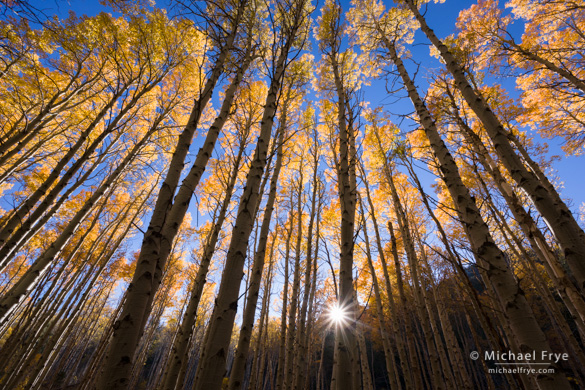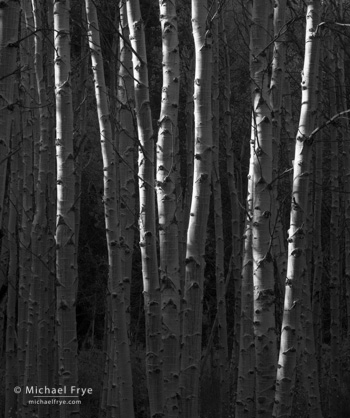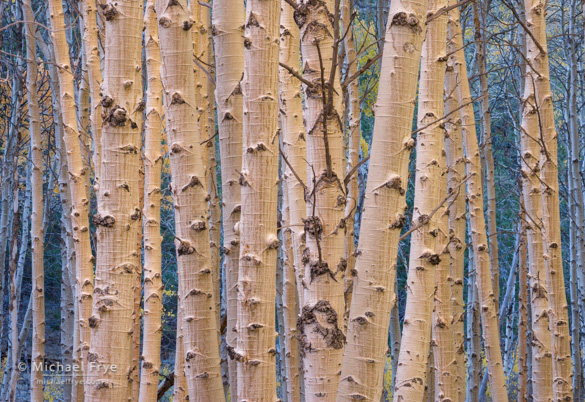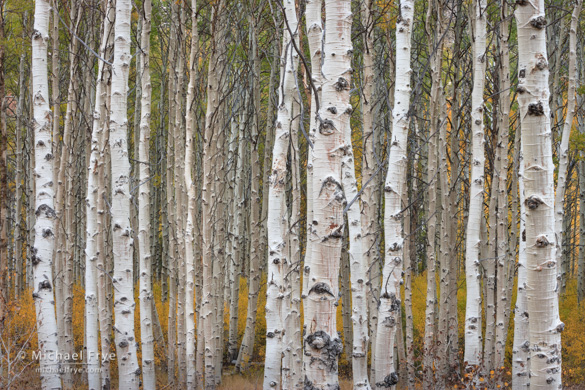Mike Osborne and I just completed our Eastern Sierra Fall Color workshop this past weekend. It was a lot of fun—wonderful people, beautiful weather, and lots of color.
The focus of this workshop was composition and creativity, and it was great to see the participants growing and learning during the class. I saw a lot of beautiful compositions and imaginative ideas on the back of people’s cameras and in the evening image-review sessions.
One of the things we talked about during this class was the creative process. This process varies from one person to another, of course, and can also change depending on the situation and subject. Sometimes—especially with my nighttime work—I plan out every detail in advance. At other times—particularly if I’m in what Mike calls a “target-rich environment,” with interesting subjects and light—then I tend to work quickly, reacting to the changing light and photographing whatever catches my eye at that moment.
The accompanying photographs show a small demonstration of that “reactive” process in an aspen grove on Saturday afternoon. When we first arrived at this spot the trees were in the sun, and the backlit orange leaves against the blue sky were a striking sight. We all tried different compositions—looking up, looking into the sun, using both wide-angle and telephoto lenses. Of my own images, I ended up liking the wide-angle frame at the top of this post the best, with the sun about to dip behind the background ridge.
As the last light caught the trees I realized that if I moved to the left I could juxtapose edge-lit trunks with a dark, shaded background (right). Then after the sun had gone I noticed a surreal color-temperature contrast, with nearby trunks catching an orange glow from some leaves in the canopy that were still in the sun, and the background a striking, deep-shade blue (below). Finally, with everything in the shade, I looked for patterns and textures, like the ones in the last photograph (bottom).
It’s worth noting that this fluidity is born of intimate familiarity with my equipment, and with the intricacies of exposure and depth of field. I’m able to make quick, almost instinctive decisions about compositions, shutter speeds, apertures, etc., because of that familiarity.
What’s your process? Slow and deliberate? Quick and fluid? Or does it vary with the situation?
The color around Lee Vining changed rapidly over the last week, and by the time I left on Sunday the color was at or near peak in all the medium- and low-elevation spots—June Lake Loop, Lee Vining Canyon, Lundy Canyon, Conway Summit, etc.
A storm moved in Sunday afternoon, so Claudia and I scurried back over Tioga Pass before it closed. The forecast for Monday and Tuesday called for snow above 7000 feet, and high winds. Those winds, unfortunately, may strip many of the leaves from the aspens. There should still be some color over there this coming weekend, but I don’t know how much.
With the color waning on the east side attention now shifts to the western slope of the Sierra. Since I’ve spent so much time in Lee Vining lately I haven’t had a first-hand look at Yosemite Valley in awhile, but my friend Kirk Keeler, staff photographer at The Ansel Adams Gallery, tells me that there’s some color starting to appear, particularly in the west end of the valley. I’ll be in the park tomorrow for a private workshop and post a first-hand report as soon as I can.
— Michael Frye
Related Post: Autumn Aspens
Michael Frye is a professional photographer specializing in landscapes and nature. He is the author and photographer of The Photographer’s Guide to Yosemite, Yosemite Meditations, and Digital Landscape Photography: In the Footsteps of Ansel Adams and the Great Masters, plus the eBooks Light & Land: Landscapes in the Digital Darkroom, and Exposure for Outdoor Photography. He has written numerous magazine articles on the art and technique of photography, and his images have been published in over thirty countries around the world. Michael has lived either in or near Yosemite National Park since 1983, currently residing just outside the park in Mariposa, California.













I like to be slow and deliberate, but the situation dictates so much of the time. Light changes really fast sometimes. Sometimes slow and deliberate means losing the shot as you see it the moment you see it. I recently missed a shot in the woods where the sun exposed for about 5 seconds, turning all the fall foliage into a glowing light show. It lasted about 5 seconds and was gone. My camera was on my tripod over my shoulder. By the time I decided to shoot, it was gone and didn’t come back before I had to move on. My favorite setting to forget about is iso.
Thanks Brad – yes, light can change really fast, and I think you have to adapt to the conditions. And sometimes lighting events are just too fleeting to capture.
beautiful Aspens Michael, I’ve been searching for a large standsof Aspens in Connectiuct but haven’t found any as of yet. I may have to go North to Vermont or New Hampshire. Leaves are mostly all fallen from the trees now in New England.
Thanks John. I don’t think there are any aspens in New England – they’re a western species. But you have plenty of even more colorful trees out there like maples and birches.
Beautiful work Michael!
I really love the back lit Aspens.
The shadows, and the angle of the setting sun, evoke a feeling that winter is right around the corner.
Thanks Paolo!
Love the edge lit aspens!!! Always partial to B&W.
Glad you made it over before Tioga Pass closed!
Thanks Kim – aspens aren’t always all about color. 🙂
Your photos are always great inspiration to me. I wish I could attend your workshop one of these day. Where are these photos taken in Eastern Sierra? I’ve been to this area quite a lot but i’ve never seen aspen groove like this.
Thank you Son. I can’t give specifics about this location but it’s somewhere in Lee Vining Canyon